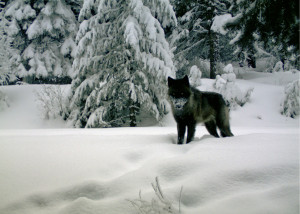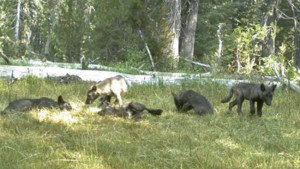By Legal Director Nick Cady
Given the state’s recent move to remove the gray wolf from Oregon’s list of threatened and endangered species, it is worth taking a full look at the history of this species in Oregon to fully put in context the recent decision.
In 1947, the last wolf was killed in Oregon as part of a government bounty program, which was part of a nationwide predator extermination campaign facilitated by federal and state governments. Upon passage of the Endangered Species Act in 1973 under Nixon, the federal government began focusing on recovering many of the species wiped out by extermination campaigns and habitat lost to industrial development.
One of the first critters focused on was the gray wolf. After 66 wolves were reintroduced over two years in central Idaho and Yellowstone National Park, individuals eventually dispersed west into Oregon. In 1999, an initial lone wolf swam the Snake River and was Oregon’s first wolf in over 50 years, but wildlife managers with the Oregon Department of Fish and Wildlife (ODFW) were politically and physically unprepared to handle wolves returning to the state. The lone wolf was darted and shipped back to Idaho. Two more wolves that crossing the Snake were killed, one poached and another run over on I-84.
This series of events began a state-sanctioned process to develop a wolf conservation and management plan in Oregon designed to address the unique relationship between Oregonians and wolves. Development of the plan involved many different stakeholders including conservation groups, livestock interests, the hunting community, county commissioners, and ODFW. A comprehensive plan was finalized in 2005, but the plan left many questions and situations unaddressed, mainly the response to wolf-livestock conflict and its intersection with the state Endangered Species Act, which has a prohibition against killing a listed species.

Wolf from the Walla Walla Pack (Photo Courtesy of ODFW)
By 2011, Oregon had its first established breeding pair of wolves, the Imnaha pack. This pack’s alpha pair produced OR-7, the famous wolf that journeyed from northeast Oregon to northern California, and the female wolf that helped establish California’s first wolf pack in almost one hundred years. But during 2010-2011, Oregon began experiencing its first wolf-livestock conflicts in northeastern Oregon, and the livestock community began pressuring ODFW to kill wolves to reduce this conflict.

Shasta Pack in California (Photo Courtesy of CDFG)
Specifically in Oregon, this meant that federal protections under the Endangered Species Act in the eastern portion of the state had been eliminated, and that the state was permitted to kill wolves. The livestock community and anti-wolf political figures began pushing hard for killing wolves in Oregon. Cascadia and others fervently reminded the state and ODFW that we only had a single breeding pair of wolves in Oregon, and approximately only 12 or 13 wolves total. Despite these protests, ODFW moved to kill the alpha male of the Imnaha pack and one of the pups born that year.ODFW determined that after only a few incidents of wolf-livestock conflict, the Imnaha pack satisfied the wolf plan’s “chronically depredating” standard and needed to be killed.
Folks at Cascadia Wildlands were outraged. We reminded the state the commitments it had made in the plan to make killing wolves a measure of last resort at this early juncture of recovery, and we disagreed with ODFW that a few incidents over the course of two years marked a “chronic” issue. We went to court over the disagreement, preventing the killing of the Imnaha pack, but ultimately settled the suit with both the Oregon Cattlemen’s Association and the ODFW. This settlement defined some of the vague terms used in Oregon Wolf Conservation and Management Plan, laid out clearly defined requirements for implementing non-lethal preventative measures, and delineated exactly what the plan meant by “chronically depredating.” Additionally, a compensation program was set up for ranchers that lost livestock to wolves, and a tax credit established to further compensate ranchers for efforts expended on preventative measures. These rules have been highly lauded as the most thorough and successfully wolf conservation and management program in the country.
ODFW began executing the clarified rules with earnest, and over the next few years Oregon saw depredations decrease dramatically and wolf numbers steadily increase. With ODFW and ranchers focusing on preventative measures, ODFW has not had to expend taxpayer dollars to kill a single wolf to date. We now have approximately 15 wolf packs in Oregon, wolves have been initially dispersing into western Oregon, and there are now potentially two new packs in southern Oregon near the California border. At the last official count, there were over 70 confirmed wolves in Oregon. This has been such a promising recovery to date, and has been one of the pride and joys at Cascadia Wildlands — a direct result of our efforts.
However, this year a new conflict over wolves has emerged surrounding the removal of the species from Oregon’s list of threatened and endangered species. When wolves in Oregon first satisfied the four breeding pairs for three consecutive years in 2014, and wolf management in eastern Oregon moved into Phase II, the state began exploring whether or not wolf numbers and recovery warranted removal of the species from the endangered species list.
Livestock interests were pushing the state hard, arguing that the state was required to remove protections for the species under the wolf plan. However, the wolf plan very clearly said that the state was only required to begin exploring the delisting process, to make an early determination over whether delisting was warranted at this time or not. Cascadia Wildlands and our conservation partners began weighing into the process as well, presenting public comments and soliciting scientific input on whether or not delisting was warranted. The “endangered” status of the wolf is critical because it provides the entire framework and backbone of the current wolf conservation and management program and the rules developed under the mutual agreement in 2011. Without this classification, the ODFW could do whatever it wants with regard to wolves, and under similar circumstances in 2011, we witnessed the state try to kill the Imnaha pack when it was the only breeding pack in Oregon.
So Cascadia Wildlands and our allies worked tirelessly to convince the ODFW that delisting was not the right move, particularly with under 80 confirmed wolves in the state. Wolves have just barely begun to get a foothold in western Oregon, and we were concerned that additional mortality associated with management of wolves in Phase II would stagnant recovery and dispersal of the species. At the end of a series of hearings this fall, in which there was an enormous amount of public and scientific testimony, over 90 percent of Oregonians had urged the state to retain endangered species protections for the species. The overwhelming message from the scientific community was that delisting was premature because of the limited numbers and distribution of the species across the state.
Despite the weight of this evidence and the desire of the public, ODFW and its Commission removed the wolf from the list of threatened and endangered species in mid-November. Cascadia Wildlands is again exploring legal options and ways to retain this critical classification for a species still very early in its recovery.
Cascadia Wildlands cannot thank enough our volunteers, members and supporters who wrote letters, talked to elected officials and traveled great distances to publicly testify in support of wolves. This passion gives us our inspiration, and we will continue to fight for this species as it continues on its perilous path to recovery. Stayed tuned for next steps as this struggle is far from over, and please consider donating to support our ongoing efforts.
